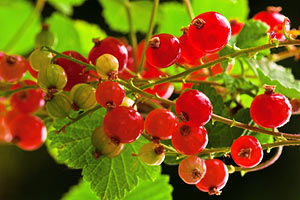
Currants

Bare-rooted currant varieties are widely available for planting between October and March. Container-grown currants can be planted all year round, as long as the soil isn’t frozen or waterlogged. Try to buy a two-year-old plant – once planted it will remain productive for almost 20 years. Grow currants in well-drained soil, which has been enriched by adding plenty of well-rotted manure. Choose a slightly sheltered spot, and although plants prefer full sun, they will tolerate dappled shade.
What to do
How to plant
- Dig a hole wide enough for the roots to be spread out and deep enough so the soil mark on the stem is level with the surface of the soil.
- Put the bush in the centre of the hole and gradually fill with soil, firming as you go.
- Water and finish by spreading a layer of well-rotted manure over the root area of each plant.
- If you’re planting a number of red and white currant varieties, leave 1.5m between plants and 1.8m between rows.
Training and pruning red and white currants
- Red and white currants should be trained as an open centred, goblet-shaped bush – this allows light and air to flow freely around the branches, and makes picking easier.
- After planting, pull off any suckers growing from beneath ground level and cut back to the stem any branches less than 10cm above the soil – this will give the bush a short leg.
- Prune all other branches to a third of their original length, cutting to an outward facing bud.
- In following years allow branches to grow in the main framework until your bush fills its allotted space. Then, prune back the upright growing leading shoots to half their length, cutting to an upright bud.
- At the end of June, prune back side shoots to half their length and then to two or three buds in winter.
Training and pruning blackcurrants
- After planting blackcurrants, prune each branch back to within two buds of ground level to leave a mass of stubby shoots.
- At the end of the first growing season, remove any spindly shoots and select one strong shoot, cutting it to soil level.
- In following winters, take out branches that grow away from the bush at a sharp angle. When fully grown, simply remove a quarter of the two-year-old branches (grey colour) and older branches (black colour) in winter, cutting right back to the base.
Aftercare
- Keep soil beneath plants weed free and remove any suckers from white and red currants.
- Ensure plants are watered regularly during dry weather, but don’t overdo it, as too much when the fruit appears can cause them to split.
- Apply a layer of well-rotted manure over the root area each spring.
Harvesting
Cut whole bunches when the fruit is ripe, but still firm.
Tip
Birds like to eat the developing buds of currant bushes, so protect plants in the winter. If you have a large garden, a fruit cage is ideal, alternatively, cover plants in bud with anti-bird mesh.
Five red, white and black currants to try
- ‘White Versailles’ – large, sweet, yellowish fruit in early July
- ‘Jonkheer van Tets’ – heavy crops of large red currants in early July
- ‘Junifer’ – masses of red currants
- ‘Ben Lomond’ – Tasty, black currants
- ‘Ben Sarek’ – Large black currants on a compact bush. Ideal for smaller gardens

